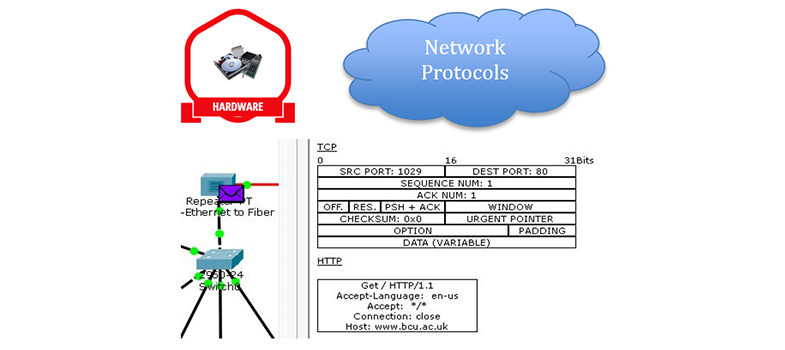Identify network hardware and protocols
1 Layered network protocols
- Network communication relies upon the interaction of many different protocols. These protocols are designed to implement a particular set of rules and conventions governing particular aspects of how devices in a network communicate.
- Network protocols are arranged in layers, with each layer providing a specialised service for the layer above. Because each layer consists of standardised protocols that perform functions to an agreed set of rules, it is possible to modify individual protocols within a layer without having to change protocols in other layers.
- To visualise this concept of layers, consider a conversation between two people:
- Content layer: ideas exchanged in conversation.
- Rules: agree to speak a common language, take turns speaking, not to interrupt when others are speaking.
- Physical: face-to-face communication requires speakers to be close enough to hear each other.
- In this example, the conversation has been divided into three layers. The physical layer considers the fundamental requirements of exchanging information between two people using speech. This includes considering the distance between the speakers, which will affect how loud each person needs to talk in order for the other to hear. Speech is a movement of air, which is translated as sound waves. This means that the conversation could take place in a ‘near’ vacuum like outer space.
- The rules layer defines how the speakers will talk. To exchange information, a common language would need to be chosen. Once the language is agreed, how is the conversation to be managed? Taking turns is a reasonable way to converse with another person and interrupting would be considered rude. But what happens if one person misses something and wishes it to be repeated? Do they ask for it to be repeated verbally, or do they use an agreed signal such as raising a hand?
- The content layer considers the actual message exchanged between the two speakers, which in a conversation may be an item of news, plans for a holiday or just gossip.
- By dividing the conversation into layers, we have decided upon the particular functions that are required by each layer to support communication, and in our simple layered model, it should be possible to change some aspects within one layer without affecting the others. For example, if we now decide to have a telephone conversation, how does this change the requirements of our physical layer?
- Networking protocols can be layered in a similar manner to the voice conversation in the example above, but has a wider range of considerations and uses different terms:
- Encoding: language to use.
- Formatting: greeting, recipient identity, closing phrase, sender identity.
- Message size: segmentation of data.
- Timing: flow control and timeout.
- Delivery: to one host (unicast), to all hosts (broadcast), to some hosts (multicast).
